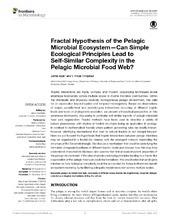| dc.contributor.author | Våge, Selina | |
| dc.contributor.author | Thingstad, Tron Frede | |
| dc.date.accessioned | 2016-12-28T12:11:31Z | |
| dc.date.available | 2016-12-28T12:11:31Z | |
| dc.date.issued | 2015-12-01 | |
| dc.Published | Frontiers in Microbiology 2015, 6:1357 | eng |
| dc.identifier.issn | 1664-302X | en_US |
| dc.identifier.uri | https://hdl.handle.net/1956/15280 | |
| dc.description.abstract | Trophic interactions are highly complex and modern sequencing techniques reveal enormous biodiversity across multiple scales in marine microbial communities. Within the chemically and physically relatively homogeneous pelagic environment, this calls for an explanation beyond spatial and temporal heterogeneity. Based on observations of simple parasite-host and predator-prey interactions occurring at different trophic levels and levels of phylogenetic resolution, we present a theoretical perspective on this enormous biodiversity, discussing in particular self-similar aspects of pelagic microbial food web organization. Fractal methods have been used to describe a variety of natural phenomena, with studies of habitat structures being an application in ecology. In contrast to mathematical fractals where pattern generating rules are readily known, however, identifying mechanisms that lead to natural fractals is not straight-forward. Here we put forward the hypothesis that trophic interactions between pelagic microbes may be organized in a fractal-like manner, with the emergent network resembling the structure of the Sierpinski triangle. We discuss a mechanism that could be underlying the formation of repeated patterns at different trophic levels and discuss how this may help understand characteristic biomass size-spectra that hint at scale-invariant properties of the pelagic environment. If the idea of simple underlying principles leading to a fractal-like organization of the pelagic food web could be formalized, this would extend an ecologists mindset on how biological complexity could be accounted for. It may furthermore benefit ecosystem modeling by facilitating adequate model resolution across multiple scales. | en_US |
| dc.language.iso | eng | eng |
| dc.publisher | Frontiers | en_US |
| dc.rights | Attribution CC BY | eng |
| dc.rights.uri | http://creativecommons.org/licenses/by/4.0 | eng |
| dc.subject | pelagic microbial food web | eng |
| dc.subject | complexity at different scales | eng |
| dc.subject | fractal-like organization | eng |
| dc.subject | Sierpinski triangle | eng |
| dc.subject | underlying ecological mechanisms | eng |
| dc.subject | killing-the-winner | eng |
| dc.title | Fractal hypothesis of the pelagic microbial ecosystem-can simple ecological principles lead to self-similar complexity in the pelagic microbial food web? | en_US |
| dc.type | Peer reviewed | |
| dc.type | Journal article | |
| dc.date.updated | 2016-11-04T08:46:56Z | |
| dc.description.version | publishedVersion | en_US |
| dc.rights.holder | Copyright 2015 The Author(s) | en_US |
| dc.identifier.doi | https://doi.org/10.3389/fmicb.2015.01357 | |
| dc.identifier.cristin | 1335629 | |

